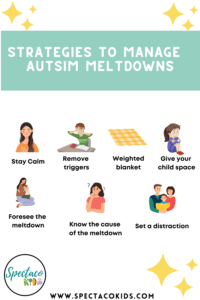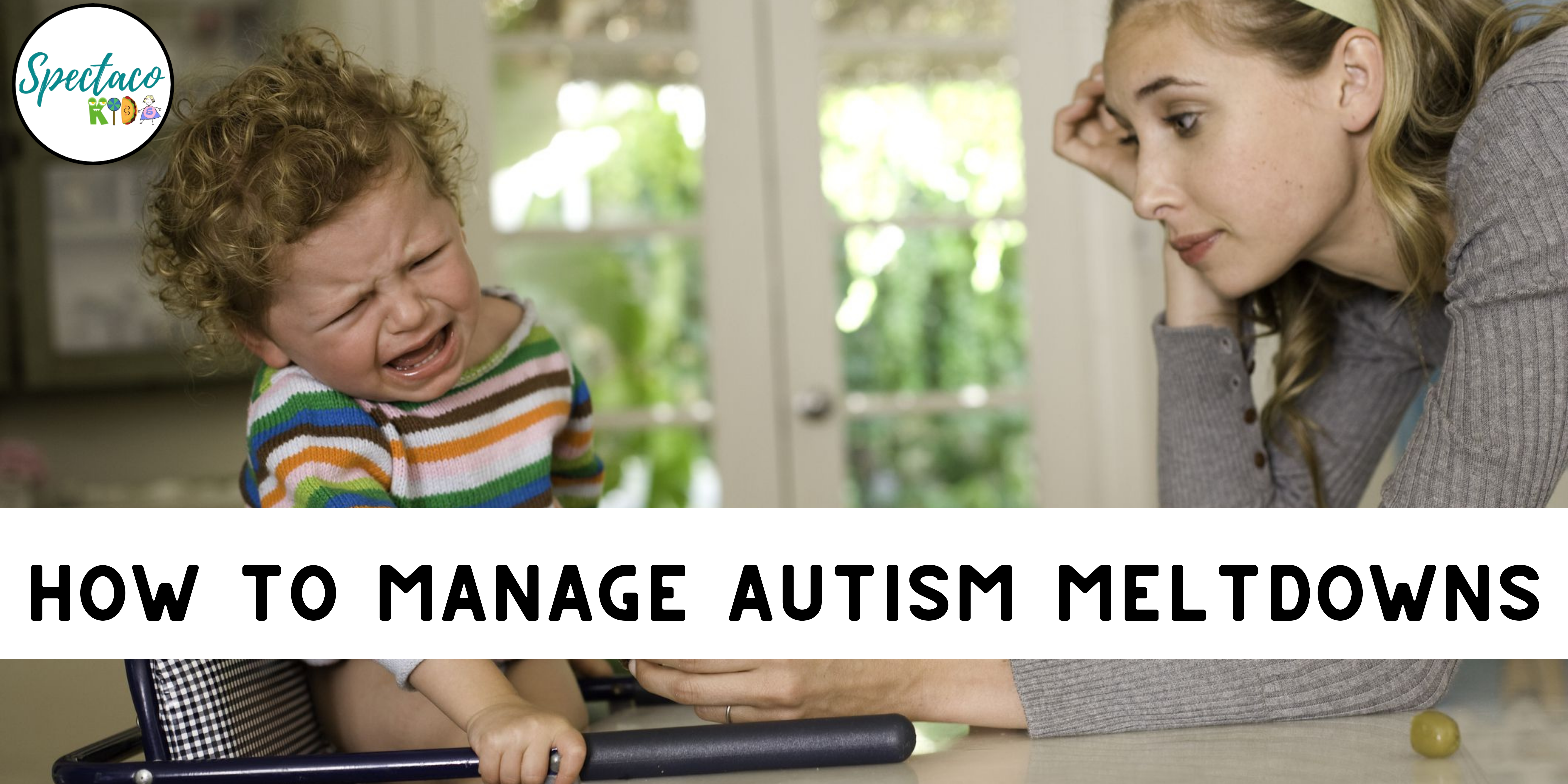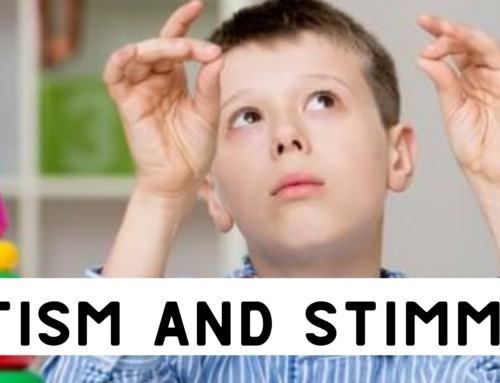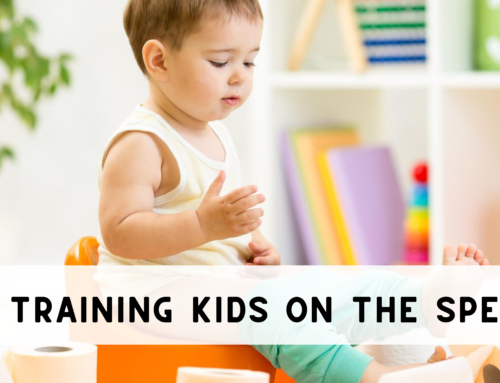Autistic children experience a lot of hardship when it comes to regulating their behavior. Sometimes even the smallest of situations can affect their mood and cause them to have a meltdown. This can become challenging for the parents to manage, especially in public settings.
What Is An Autism Meltdown?
Unlike tantrums, autism meltdowns are not used as a tool to get something the child wants. Infact, it represents a loss of control. A meltdown is an intense response to new or overwhelming situations faced by the individual. This in turns causes them to lose control.
What Causes A Meltdown?
Some of the reasons why people on the spectrum experience meltdowns are listed below:

- ADHD – disability to focus and getting bored can lead to outbursts
- Learning Problems – learning disorders can increase frustration and cause meltdowns
- Anxiety – can cause a child to be overwhelmed when in new or uncomfortable settings
- Sensory Challenges
- Inability to manage situations – can make it difficult for autistic children to cope with situations that may arise there and then, thus, making it harder for them
- Difficulty understanding societal norms
- Difficulty in speaking
- Trouble following or using non-verbal communication
- Uncertainty about what others are thinking about you
- Hesitancy to be social
What Else Do I Need To Know About Meltdowns?
Some other facts regarding the nature of autism meltdowns are as follows:
Can occur at any point in time, whether in children or adults:
This could make the situation for parents tricky as each stage comes with its set of challenges, especially if the individual does not explicitly show signs of disability.
Do not have any intended purpose:
Whilst children throw tantrums to get what they want; meltdowns represent and internal crisis and require urgent help.
Often occur after some warning signs:
You will notice that before you witness an individual experience an autism meltdown, there will surely be some clear signs of distress to watch out for. These can be verbal or even physical in nature.
May Include self-stimulating behaviors either before or after the meltdown:
These can identified as pacing, tapping feet, rocking to and fro for example.
What Does An Autism Meltdown Look Like?
Autism meltdowns can manifest in many ways. Every individual experiences different emotions of varying magnitudes. However, some common things to look out for are:

- away
- Zoning out
- Crying Excessively
- Yelling and Screaming
- Social Withdrawal
- Displaying aggression, hitting, or kicking others
- Self-harming behaviors like biting or head banging
How To Prepare Yourself To Manage A Meltdown?
Some useful tips to help prepare you to manage a meltdown are listed below:

-
Know the cause of the meltdown
It is very important that you understand your child’s behavioral patterns. This helps you to stay informed and prepare yourself before something takes place. It’s best to record your child’s behavior before, during and after a meltdown so you know just what to do and can better understand your child’s reactions and plan what can be done about them the next time round.
-
Foresee the meltdown before it occurs
As highlighted above, there are certain signs one can expect before a meltdown. When these signs of anxiety and distress appear, it is best to take immediate action and create a diversion or remove the main reason for the anxiety if possible.
-
Minimalize factors that prompt a meltdown
The best way to do this is to avoid things that may trigger your child, like loud music for example or overcrowded places. Additionally, teach your child coping strategies so that they can better manage themselves in unfavorable circumstances and be able to control their emotions.
-
Stay calm
This is one of the most important things to bear in mind when dealing with complex situations. This skill can also be taught to your child so that they can become more relaxed in unnerving situations.
-
Give your child space
Sometimes giving children their space can solve many problems and help them to relax faster, especially during a meltdown. When surrounded by people, this may be a good way to help both you and your child, by coming to an understanding about what must be done when in case of a meltdown.
-
Setup a distraction
After your child has calmed down a little, you can create a diversion to divert their attention onto something more useful, which appeals to them. This will help to curb the meltdown quicker and keep your child happy too.
What Are Some Useful Sensory Tools For Autism Meltdowns?
Sensory toolkits can be very helpful when it comes to managing your child’s meltdown. It’s a good idea to pack these and carry them whenever you are on the go so they are readily available when you need them. Here’s a list of a few things that could come in handy:
-
Noise-cancelling headphones
These headphones use noise-cancelling technology that helps to minimize outside noise and can be a great way to protect your child from places with loud music for example.
-
Sunglasses
If your child is sensitive to light, sunglasses can shade them from very bright lights.

-
Weighted Blanket
Weighted blankets are a great way to calm autistic children as they add pressure and are warm, making them feel cozy and safe.
-
Crunchy or chewy snacks
Crunchy or chewy snacks have a calming effect when kids get cranky and are hungry.
-
Fidget Toy
These repetitive toys are simple to use and fun to play around, especially in stressful situations as they provide a calming effect.
-
Scented Hand Lotion
Good-smelling scents provide a soothing effect especially when inhaled and area quick and cheap method to help your child during meltdowns.
-
Hand Wipes
Children with tactile sensitivities can touch some things that may irritate their skin. These wipes com very handy to cool down the irritation.
Whilst meltdowns aren’t always the easiest to deal with, there are many methods that parents can use to manage their child’s emotional wellbeing.




